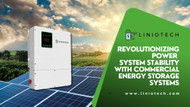Revolutionizing Power System Stability with Commercial Energy Storage Systems
Posted by LinioTech on Oct 26th 2023
The significance of power system stability in this fast changing energy landscape cannot be emphasized. Maintaining a steady and dependable energy supply now faces additional difficulties with the inclusion of renewable energy sources like solar and wind power into the electrical system. Commercial Energy Storage Systems (CESS) provide creative ways to improve power system stability in situations like this.
The Quest for Power System Stability
The ability of an electrical grid to sustain a continuous supply of electricity without disruptions or notable variations in voltage and frequency is known as power system stability. Fossil fuels, like coal and natural gas, were a major component of traditional power generation since they provided steady power output and guaranteed grid stability.
But the energy mix has changed as society moves toward cleaner, more sustainable energy sources. Even though they are good for the environment, renewable energy sources frequently produce electricity sporadically. There are times when the wind blows and times when the sun shines. Power grids now have additional difficulties in preserving stability and dependability.
Enter Commercial Energy Storage Systems
CESS, or commercial energy storage systems, have become a ground-breaking way to deal with these stability issues. When renewable energy generation is high, such as on a sunny day with excess solar power or on a windy night with extra wind energy, CESS makes it possible to capture and store excess energy.
When demand surpasses supply or renewable energy sources are not producing electricity, the stored energy can be released, functioning as a buffer to maintain system balance. This skill makes a major contribution to the stability of the power system in multiple important ways:
1. Grid Frequency Regulation
Commercial Energy Storage Systems are able to quickly add or take away power in order to keep the grid frequency within reasonable bounds. A stable grid ensures that all linked equipment and gadgets perform as intended by maintaining a constant frequency, often 50 or 60 Hz. Frequency variations that might cause equipment damage or power outages are less common thanks to CESS.
2. Voltage Control
Ensuring power quality and the correct operation of electrical devices depends on maintaining the optimal voltage levels throughout the grid. By controlling voltage levels, CESS can offset variations brought on by different loads and sporadic renewable energy production.
3. Peak Demand Management
In order to maintain power system stability, controlling peak demand times when electricity consumption spikes is one of the biggest problems. During these periods of peak demand, CESS can release stored energy, relieving pressure on the grid and averting possible brownouts or blackouts.
4. Grid Resilience
Commercial Energy Storage Systems give electricity systems an extra degree of resiliency. CESS can supply backup power to vital infrastructure in the event of unforeseen circumstances, such as natural catastrophes or equipment malfunctions, assisting in the continued provision of key services under challenging circumstances.
5. Enhanced Integration of Renewables
Greater integration of renewable energy sources is made possible by the capacity to store excess energy. No matter the weather, CESS can store excess energy produced during times of strong renewable output, guaranteeing a more reliable power supply.
Real-world Applications of CESS
Commercial Energy Storage Systems are actively changing the energy landscape; they are not merely theoretical ideas. The following practical uses demonstrate how well they work to improve power system stability:
1. Grid Balancing
CESS is being used by grid operators more and more to balance the grid during spikes in renewable energy production. They can guarantee a seamless shift from fossil fuel-based power generation to a more sustainable energy mix by strategically building energy storage.
2. Microgrids
Microgrids are self-contained electrical systems that frequently use CESS to independently control their power supply. Because of this, microgrids can function independently of the main power grid or as reliable backup power sources.
3. Energy Arbitrage
Purchasing power at a discount and selling it at a premium are known as energy arbitrage. By storing energy when it's cheap and releasing it during times of peak demand when prices are higher, CESS is essential to this strategy.
4. Renewable Energy Integration
Renewable energy sources must be integrated into the grid with the help of energy storage devices. When renewable energy sources generate more energy than is immediately required, they can store the excess and supply it when demand outpaces supply.
The Future of Power System Stability
Commercial Energy Storage Systems will become more and more important in guaranteeing power system stability as the globe keeps moving toward greener and more sustainable energy sources. Preventing blackouts and grid disruptions will largely depend on their capacity to properly integrate renewable energy sources, control peak demand, and regulate frequency.
The efficiency and dependability of CESS technology will only increase with further research, including breakthroughs in energy management and battery technologies. With these developments, power system stability will no longer be a worry but a guarantee in the future, even in the face of constantly shifting energy sources.
In a world quickly moving toward renewable energy, the integration of Commercial Energy Storage Systems with the power grid offers a major step toward assuring power system stability. In this transition, CESS serves as a pivot, guaranteeing that the machines and lights continue to operate independent of the energy source. We can count on CESS to deliver the stability we need to power our future as the energy landscape changes in front of our eyes.

